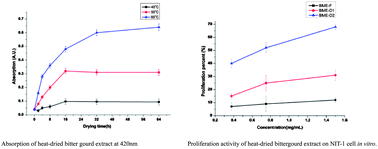Increase in the free radical scavenging capability of bitter gourd by a heat-drying process
Abstract
Bitter gourd (Momordica charantia Linn.) is widely regarded as one of the best remedy foods for diabetes. The positive effect of bitter gourd on diabetes has been attributed in part to the remarkable free radical scavenging activity of its boiled water extract from sun-dried fruits. It is well known that a heat process significantly influences the antioxidant activity of fresh fruits. However, the heat drying processes of bitter gourd have not been studied so far. Here, we show that the free radical scavenging capability of bitter gourd extract significantly increases after the heat drying process, while the content of flavonoids and phenols, which are generally regarded as the main antioxidant components in bitter gourd, remain unaffected. Furthermore, the content of free amino acids and the total reducing sugar were found to decrease with increasing browning index, indicating the progression of the Maillard reaction, products of which are known to possess significant antioxidant activity. Therefore, it suggests that Maillard reaction products may be the main contributors to the increase in antioxidant capability. Finally, the bitter gourd extract with the higher antioxidant activity, was shown to manifest a corresponding higher proliferation activity on NIT-1 beta-cells. These results suggest that controllable conditions in the heat-drying processing of fresh bitter gourd fruit is of significance for enhancing the total free radical scavenging capacity, beta-cell proliferation activity and possibly the anti-diabetic activity of this fruit.


 Please wait while we load your content...
Please wait while we load your content...